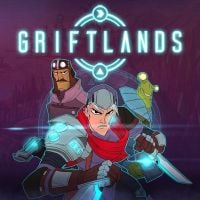Here you will find a description of all the useful features and messages that will make your gameplay easier.
You will also learn hotkeys and controls in Griftlands.
Main user interface
This interface accompanies you throughout most of the gameplay.
In the upper right corner there is a portrait of your hero.
After targeting it, you’re able to see a brief summary of your character.
This allows you to learn more about story' background.
Use the former for duels and the latter for negotiations.
Starting from the left, the bug reporting screen is visible.
I didn’t come across any that would’ve made it impossible for me to play the game.
Just a few graphics glitches.
However, it is good that developers thought about such a solution.
Moreover, you’re free to immediately send a screenshot revealing a problem even without leaving the game.
Then there is a tab with your relationships with other characters.
It contains a ranking list of separate characters which reveals how much a certain character likes us.
Next you have an icon responsible for your “grafts”, i.e.
You have 3 items supporting the fight at your disposal.
And the same number of items to assist in negotiations.
During the game you’re free to find additional slots in your armor.
When you move the mouse pointer over an item, you get information about its effects and possible disadvantages.
Later on there are two icons responsible for combat and negotiating decks.
you’re free to find your current cards in them.
Also, it’s possible for you to see the progress in improving them and see two possible evolutions.
However, this does not apply to all cards.
The basic cards receive two random “evolutions” when upgraded.
World map
Playing our heroine Sal we get to a location called Havari.
The whole action is taking place in this land.
Completing subsequent tasks, you move along its paths.
During this time you might find random activities.
Also, after a task is completed, the map gets updated.
Some tags disappear and new ones appear.

So the sequence of tasks is important.
Negotiations
In Griftlands we have two alternate ways to fight.
One of them are negotiations.
It consists in defeating the opponent by reducing his “resolve” points to zero.
At the same time you give a shot to maintain your resolve stat at high level.
At the beginning of negotiations we get 5 cards, and arguments for you and the opponent are distributed.
They are the result of the relationship with other heroes or the skills of the opponent.
We can also bribe a character to help us negotiate.
This circle shows the personality of the opponent.
This is a skill that works throughout the negotiations.
The opponent has a second smaller circle.
It shows the opponent’s intentions for the next round.
This makes it easier for you to respond to his or her attacks.
By pointing the cursor at an argument or intention, you might read more information.
Also, you may check your armor improvements there, if you have any.
At the bottom from the left you might see cards that you will draw in the next round.
For each turn you draw 5 cards, the rest goes to the pool of discarded ones.
Then it’s possible for you to see the number of action points.
Below is the surrender button.
It’s available only in the negotiations mode.
It results in the interruption of negotiations and the loss of negotiated benefits.
However, you do not recover the lost “resolve” points.
To the right of these buttons is a set of discarded cards and a trash can.
The first is used to store the not-played cards.
If a set of draw cards has exhausted, the cards are moved from there.
A unique throw in of negotiation is the negotiation of an additional payment for a task.
Unlike conventional negotiations, this is where you want to eliminate all side arguments.
Usually they are 3 of them.
The more resolve points they have, the more bonuses you will get for hitting them.
The amount of bonuses gained for destruction of each argument is reduced by 25% for each turn.
Combat
Combat and battles are very similar to negotiations.
Despite that, combat has several differences.
Instead of using “resolve” points, you use health points and use a different set of cards.
In case of a loss in negotiations, you lose only all ‘resolve’ points and the negotiated bonuses.
However in case of battle death means the end of the game.
To avoid this, you’ve got the option to pay heroes to help you in battle.
Above a character, you might see an indicator that tells you about upcoming damage.
Under the character you may see the current buffs and debuffs.
After hovering you mouse pointer over them you could read more information about them.
Below you could see a health bar.
All other characters except our main character have a two-part health bar.
The system of playing cards is identical to the one used in negotiations.
For action points you play cards.
The game ends with the opponents surrender, get defeated or lose all their health points.
Controls and hotkeys
Griftlands is a card game and has a very simple controls.
It’s limited to controlling the mouse and a few keyboard shortcuts to simplify gameplay.
Use right mouse button (RMB) to check card improvements when selecting them.
It is possible to see in advance whether the improvement suits you.
you could also hover the mouse pointer over an icon or underlined word.
Then, you will see additional information about a location, card, character, faction or effect.
This site is not associated with and/or endorsed by the Klei Entertainment or Klei Entertainment.
All logos and images are copyrighted by their respective owners.